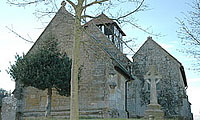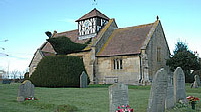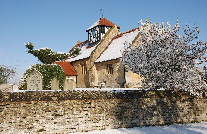|
|
||||||||
 |
|
Church of St Margaret at Alstone The original church of St Margaret at Alstone dates from the 12th century but it was extensively rebuilt in the 13th century and further modernisation and enlargement took place in the 16th and early 17th centuries. The dates at which the rebuilding took place coincide directly with two great periods of economic and population growth in England, when churches were found to be too small to cope with the numbers of parishioners. The north aisle, for example, is known to have been added in the late 1550s, possibly using materials from the dissolved Hailes Abbey. The work may have been carried out by the Peart family of masons, who first appear in Alstone records in 1557 and continued to the 20th century. The church was extensively restored between 1876 and 1880. The nave dates from the 13th century. The south wall contains two late 16th/17th century windows. The most westerly of these displays fragments of 15th century stained glass, originally part of an Annunciation scene and a St Gregory’s Mass, with Christ displaying the wounds of the Passion. In 1818 these fragments were in the east window of the 16th century north aisle and may therefore also have come from Hailes Abbey; they were moved to their present position after that date and in 2004 were releaded and rearranged. There is also a carved stone boss of a man’s head on the south wall, typically 13th century in style; and another curious feature is the carving of a human ear set in the wall behind the pulpit (the preacher will know that at least someone is listening!) The chancel appears to be of the same date as the nave but the chancel arch, perhaps the most striking part of the church, is earlier. The columns of the arch have finely moulded bases and scalloped capitals decorated with a rectangular pattern. These columns, of which only the north one is original, must be 12th century. The East window has two threefold lights from the 1250s and the south window of the chancel is of Jacobean construction. The chancel also contains a 12th century piscina. The south door is a fine 12th century piece, with the distinctive pattern of the chancel arch repeated on the door shafts and the lintel. The porch before this door is dated 1621. The wooden bell tower is rectangular with a hipped roof and dates from the restoration of 1880, replacing the 16th century turret which housed two small bells. The present bell by Rudhall of Gloucester was the gift of churchwarden John New in 1790. The 1880 clock, which strikes the hours, is by Howlett of Cheltenham. As a project for the 2000 Millennium celebration, the movement of the clock was electrified, thus obviating the hazardous weekly ascent of a tall ladder for the mechanism to be wound by hand. The entire wooden floor of the church was replaced in February 1992 after the discovery of extensive wet and dry rot in the supporting joists. The church was entirely reroofed in 2006 and the lighting upgraded. Church and churchyard have some interesting memorials. The north aisle was the burial place of the Darke family who came to what is now Alstone Manor in 1545. The north wall has a tablet placed by Thomas Darke with memorial verses to his wife Frances who died in 1671. In the porch is a headstone commemorating William Wood who died in 1625 and on the outside chancel wall is a crudely carved memorial to Sarah Hyde of Little Washbourne who died aged 13 in 1710. Outside the west end is a much decayed vaulted tomb of the 1870s of four members of the Gist family of Dixton and Wormington, and later of Alstone Manor.
. |
| [Home] [Chapelries] [Alstone] [Teddington] [Little Washbourne] [Parish Information] |
 |
|||||
 |
|||||
 |
|||||